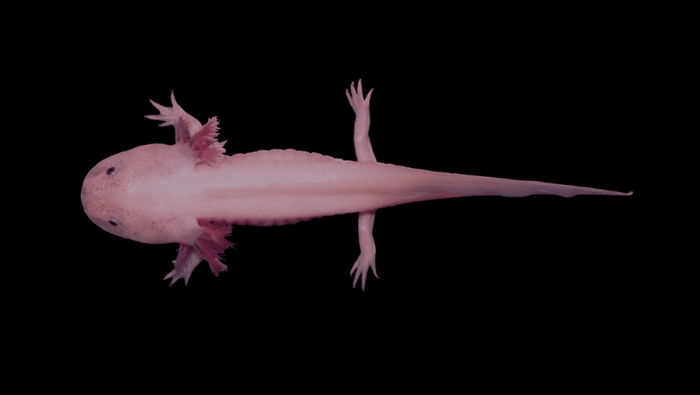Axolotls (Ambystoma mexicanum) never outgrow their larval, juvenile stage, in a phenomenon called neoteny. In addition, the animals are known for their ability to regenerate damaged appendages and internal organs.
Mammals are almost incapable of regenerating the lost tissue incurred upon brain injury. Brain regeneration requires the coordination of complex responses in a time and region-specific manner. Being able to identify the cell types and molecules involved in brain regeneration would advance our understanding of the processes involved and provide potential targets for regenerative medicine.
To better understand this process, BGI and its research partners applied their spatial technology, known as stereo-seq, to reconstruct the axolotl brain architecture during developing and regenerating processes at single-cell resolution.
Examining the genes and cell types that allow axolotls to regenerate their brains may be the key to improving treatments for severe injuries and unlocking regeneration potential in humans.
This work was published in Science in the paper, “Single-cell Stereo-seq reveals induced progenitor cells involved in axolotl brain regeneration.” The paper was one of three studies published that, taken together, present single-cell transcriptomics analyses that give evolutionary context to salamander brains by comparing them with those of lizard, turtle, and mouse.

The research team collected axolotl samples from six development stages and seven regeneration phases with corresponding spatiotemporal Stereo-seq data. The six developmental stages included: the first feeding stage after hatching (Stage 44), the forelimb development stage (Stage 54), the hindlimb development stage (Stage 57), juvenile stage, adulthood, and metamorphosis.
The team was able to identify 33 cell types present during development and 28 cell types involved in regeneration, including, they say, different types of excitatory and inhibitory neurons, and several ependymoglial cell subtypes.
Through the systematic study of cell types in various developmental stages, researchers found that during early development stage neural stem cells located in the ventricular zone region are difficult to distinguish between subtypes, and with specialized neural stem cell subtypes with spatial regional characteristics from adolescence, thus suggesting that various subtypes may have different functions during regeneration.
Researchers generated a group of spatial transcriptomic data of telencephalon sections that covered seven injury-induced regenerative stages. After 15 days, a new subtype of neural stem cells, reaEGC (reactive ependymoglial cells), appeared at the wound area.
Partial tissue connection appeared at the wound, and after 20 to 30 days, new tissue had been regenerated, but the cell type composition was significantly different from the non-injured tissue. The cell types and distribution in the damaged area did not return to the state of the non-injured tissue until 60 days post-injury.
The key neural stem cell subtype (reaEGC) involved in this process was derived from the activation and transformation of quiescent neural stem cell subtypes (wntEGC and sfrpEGC) near the wound after being stimulated by injury.
What are the similarities and differences between neuron formation during development and regeneration? Researchers discovered a similar pattern between development and regeneration, which is from neural stem cells to progenitor cells, subsequently into immature neurons and finally to mature neurons.
By comparing the molecular characteristics of the two processes, the researchers found that the neuron formation process is highly similar during regeneration and development, indicating that injury induces neural stem cells to transform themselves into a rejuvenated state of development to initiate the regeneration process.
The single-cell spatial transcriptome of the axolotl telencephalon, a tetrapod vertebrate, the authors noted, “provides data useful for further research in developmental, regenerative, and evolutionary brain biology.”



